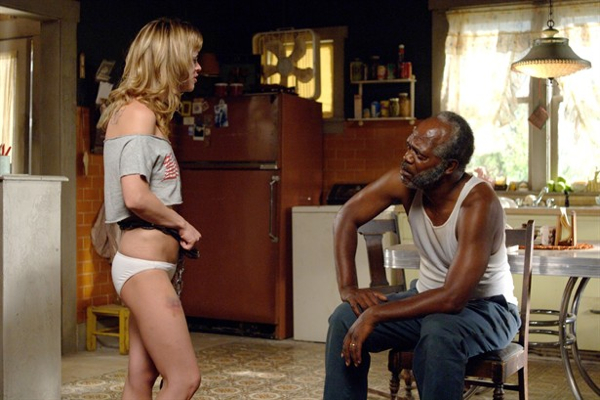Movie review by Greg Carlson
“Black Snake Moan,” writer-director Craig Brewer’s follow-up to his surprise hit “Hustle & Flow” appears eager to flaunt its obvious politically incorrect pitfalls. As if its racism and sexism aren’t enough, the movie operates from a simplistic social conservatism that argues in favor of marriage as a cure-all for even the deepest psychic scars. The film’s expertly designed poster is better than the movie, and equally as provocative. A scantily clad young white woman is held on a chain by a much older black man in a mock dime store pulp novel cover complete with creases, tatters, and stains.
Brewer’s visual sensibility injects those paperback imperfections directly into the style of his movie. Taking place in a rural Tennessee backwater seemingly frozen in the 1970s, “Black Snake Moan” intertwines the lives of two wildly different people. Rae (an underfed Christina Ricci) is a sexual abuse and rape victim whose only comfort is a jittery National Guardsman shipping out to Iraq. Lazarus (a weathered-looking Samuel L. Jackson) is a hardscrabble produce farmer and once-upon-a-time blues musician whose wife has left him for his own brother. Following a chemically-enhanced evening that sees Rae and Lazarus separately messed up, their paths finally cross when Laz discovers a bloodied, incapacitated Rae outside his shotgun shack.
What happens next belongs to the tradition of vintage exploitation cinema, as the grieving Lazarus takes it upon himself to “cure” Rae of her outrageous, misplaced nymphomania. Despite Jackson’s fine effort, his character is reduced to the age-old stereotype of the spiritual, self-sacrificing African American who corrects a deficiency in an undeserving white person. Brewer’s decision to have Lazarus chain Rae to his radiator lacks the necessary groundwork to achieve any kind of verisimilitude, but Ricci and Jackson turn the shocking scenario into a battle of wills laced with an off-kilter humor. Many viewers, however, will not find laughs of any kind in the situation.
To make matters even more salacious, Rae is periodically gripped by an uncontrollable desire to couple with any man within arm’s reach. Brewer initially seems smart for sidestepping any real sexual tension between the two principals, but Lazarus’ steadfastness also eliminates the film’s arguable primary thematic opportunity. Instead, the filmmaker widens the circle of folks who know about Lazarus’ reluctant captive to include a local adolescent and a sensible minister who takes the shocking situation in stride.
“Black Snake Moan” never manages to reconcile its over-the-top improbability with its pedestrian platitudes about salvation and redemption. Its final overtures are so odd and awkward that they veer dangerously close to ridiculousness. Only a last minute coda manages to return matters to earth. Brewer bookends the movie with footage of Son House explaining the connection between sex and the blues, and his appearance simply serves as a reminder that the film’s take on music works much better than its corny sex, age, and race-transcending friendship angle. Even though the best scene in the movie is a slow-motion gutbucket juke-joint jam and dance session, “Black Snake Moan” is too long and not nearly insightful enough to demand much respect or attention.
